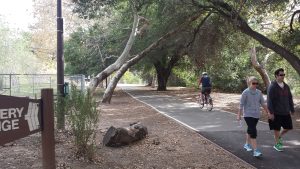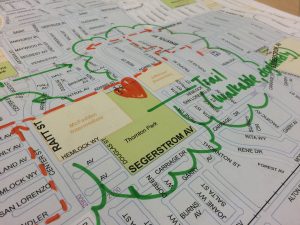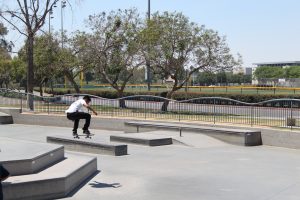|
Ref #
|
Implementation Action
|
Agency / Time Frame
|
|
Goal OS-1: Provide an integrated system of accessible parks, recreation facilities, trails, and open space to serve the City of Santa Ana.
|
|
1.1
|
Park needs assessment and master plan. Create, adopt, and implement a park needs assessment and master plan, based on community input, defining park service areas according to best practices, establishing a service area for each park facility, creating a tool to evaluate needs and prioritize improvements by quadrant or appropriate geographic subarea, and maintaining a list of priorities for the expansion and improvement of open space and recreational facilities in each quadrant or geographic subarea to attain a park land standard of three acres per 1,000 residents.
|
PRCSA 2022
|
|
1.2 
|
Interagency Forum. Convene an interagency forum to take a coordinated approach to evaluating the feasibility for converting City-owned properties to parkland, with special focus in park deficient and environmental justice areas.
|
PRCSA 2022
|
|
1.3
|
Annual Open Space Summit. Convene an annual forum to bring together City interagency staff, community leaders, and private enterprise to establish goals for park acquisition and review a status report of metrics associated with progress.
|
PRCSA 2023 & ongoing
|
|
1.4
|
No-net-loss of parkland. Establish land use provisions in the Municipal Code that prevent a net loss of public parkland in the City of Santa Ana. Require at least a 1:1 replacement if there is any loss of public parkland or City- owned open space due to public or private development.
|
PRCSA 2022
|
|
1.5
|
Park Opportunity Fund. Incorporate General Funds, cannabis revenues, and private donations into an established Park Opportunity Fund to leverage for matching grants and have monies available when opportunities arise for new park acquisition.
|
PRCSA 2022 & ongoing
|
|
1.6
|
Development fees. Update the City’s Acquisition and Development Ordinance to increase the parkland dedication requirements to meet three acres of parkland per 1,000 residents. Require that fees collected in place of parkland dedication to be utilized to acquire or expand facilities within geographic proximity to new development or parkland deficient areas.
|
PRCSA 2022
|
1.7  |
Public parkland requirements for residential projects. Update the Residential Development Fee Ordinance for large residential projects, which include projects of 100 residential units or more, to require public parkland within the City limits and a 10-minute walking distance of the new residential projects.
|
PBA/PRCSA 2022
|
|
1.7A 
|
Open space and park land incentives. Allow developers a reduction in on-site open space by giving credits for park land for public use. Establish a process and program to incentivize developers to provide additional on-site and/or publicly accessible open space to create public park land and open space. Research and collaborate with residents, developers, and community organizations to design and implement an open space density bonus to incentivize the creation of additional on-site open space in exchange for more density in the project.
|
PBA & PRCSA 2022-2027
|
|
1.8
|
Park Foundation. Establish a 501(c)(3) Parks and Recreation Foundation to establish fundraising support for Santa Ana’s park system. Identify communication protocols, roles and responsibilities, and bylaws.
|
PRCSA 2023 & Ongoing
|
|
1.9
|
Right-of-way use. Coordinate with public agencies, railroads, and utilities to determine the feasibility of acquiring the use of rights-of-way for restricted use by the public.
|
PRCSA/PWA Ongoing
|
|
1.10 
|
New parkland collaborative. Coordinate with property owners to explore options to provide public access and programming on privately-owned open space in park deficient areas, including options to acquire land through purchase, land dedication, easements, and land leases that would allow for permanent or temporary public use of land for open space and recreational opportunities.
|
PRCSA 2022 & ongoing
|
|
1.11 
|
Joint-use agreements. Coordinate with public school districts, private schools, and other community organizations to provide community members with access to additional open space and recreational resources.
|
PRCSA 2022 & ongoing
|
|
1.12
|
Santa Ana River. Update the Santa Ana River Vision Plan to expand opportunities to reintroduce natural elements, increase habitat, and provide more recreational opportunities.
|
PRCSA/PWA 2024
|
|
1.13 
|
New programming in underserved areas. Partner with community organizations to offer new programs that are accessible to residents who live in areas underserved by open space and recreational facilities. Develop a comprehensive partnership policy providing guidelines that can be used throughout the City organization.
|
PRCSA 2022
|
1.14  |
Community partnerships. Continue building partnerships with community-based organizations that administer social services to the elderly, youth, and other special needs groups; create use agreements for these providers to use public park facilities to meet the recreational and educational needs of these groups.
|
Ongoing
|
|
1.15 
|
Community input. Identify and utilize multilingual and interactive community engagement tools, initiated through the Parks and Recreation Master Plan, for residents and facility users to provide ongoing input about open space needs, park design, facility improvements, and programming.
|
PRCSA 2022
|
1.16  |
Acquisitions to meet park standard. Using the Park Master Plan as guidance, identify and acquire property within the City for park and open space use which will focus on bringing the park and recreation system to three acres of land per 1,000 residents with a plan to keep pace with future urban growth.
|
PRCSA 2022 & ongoing
|
|
Notes:
CDA – Community Development Agency; CMO – City Manager’s Office; HR – Human Resources Department; PBA – Planning and Building Agency; PWA – Public Works Agency; PRCSA – Parks, Recreation and Community Services Agency; PD – Police Department
 associated with environmental justice policies associated with environmental justice policies
|






